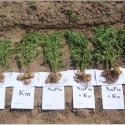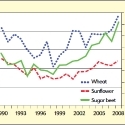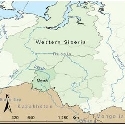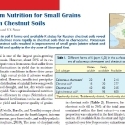Educating Farmers and Crop Advisers About Ecological Intensification

In India
Maize is considered the third most important food crop among the cereals in India and contributes nearly 9% of the national food basket (Dass et al., 2012). Maize yields in India need to increase signifi cantly to meet the country’s growing food, feed, and industrial needs of a population with a current annual growth rate of 3 to 4%. Increasing maize production in India is associated with other challenges such as better resource use effi ciency, cropping sustainability, and safety to the environment and ecosystems. Under such circumstances, the principles of ecological intensifi cation (EI) can help to create new management systems that could improve upon current farmer practices.
In India, agriculture is done mostly by smallholder farmers, that operate under a wide range of soil, climate, and socioeconomic conditions. Farmers often over or under use fertilizer nutrients or apply them in an imbalanced manner, at an inappropriate time, or by an incorrect method. Such practices result in low crop productivity with less economic return and often leave a large environmental footprint for fertilizer. Developing EI practices and promoting large scale dissemination of such practices to farmers could offer an improved crop management strategy to intensify maize production, improve input use efficiency, and ensure environmental protection.
In Russia
Maize production in Russia is growing as farmers respond to high domestic demand from the livestock and poultry industry. Russia has achieved self-suffi ciency in maize production recently and has become a net exporter. Maize area increased about 1.6 times between 2011 and 2015. However, the average maize yield in Russia during the last fi ve years (2011-15) was only about 4.4 t/ha. The current nutrient use in maize is only 55 kg N, 22 kg P2O5, and 13 kg K2O/ha (ROSSTAT, 2016), which is quite inadequate and unbalanced to sustain higher maize yields in the region. Also, yields in the southern region are commonly affected by hot and dry periods in July that limit maize pollination and grain formation.
In Russia, the agricultural producers are categorized into three general types: 1) agricultural enterprises (joint stock companies, subsidiaries of agro-holdings), 2) commercial farmers, and 3) subsistence farmers. In the Rostov region in 2015, they represented 67, 31, and 2% of the crop area, respectively. Rostov is one of the regions with a high proportion of commercial farmers. These commercial farmers, however, have generally less knowledge of nutrient management options for intensive production systems, and hence produce lower crop yields compared to agricultural enterprises (Nazarenko et al., 2011). Education of this category of producers about EI management systems is widely needed.
Critical Practices
Ecological intensifi cation integrates the best management practices that contribute to increasing crop yields over existing farmer practices in a sustainable way.
In India, nutrient management was the major intervention under EI, where 4R Nutrient Stewardship, the principle of applying the right source of nutrients at the right rate, the right time and in the right place, was followed to achieve higher maize yields. The EI treatment for summer maize received 180 kg N, 90 kg P2O5 and 100 kg K2O/ha, along with secondary and micronutrients, which were supplied through appropriate sources, at the right physiological stages, and placement method. Right nutrient management was also combined with many other best crop management practices such as choice of high yielding genotype (promising hybrids of the region), ideal planting time, optimum planted population, residue management, crop rotation with legume etc. Similarly, EI management in southern Russia considered balanced application of NPK fertilizers, splitting the N rate, and application of starter PK fertilizers. Right nutrient management was combined with optimum planting time and seed treatment with Zn.
In India, long-term evaluation of the EI system (2009-10 to 2014-15) over farmer practice (FP) at Ranchi, reported a signifi cantly higher mean grain yield of maize (6.3 t/ha), which is 163% higher than FP. Similarly in Dharwad, the EI system resulted in signifi cantly higher maize yield (5.4 t/ha), which was higher than FP by 24%. The difference in maize grain yield between EI and FP was signifi cant at both the locations across six consecutive maize seasons (2009-10 to 2014-15). The magnitude of yield difference between EI and FP was higher at Ranchi than at Dharwad (Figure 1). The soils of Ranchi were red and lateritic in nature, relatively low in soil fertility, acidic (pH 5.1), and low in organic C (0.43%). The soils of Dharwad were Vertisols, relatively high in native fertility, with neutral soil pH (7.2), and medium organic C (0.56%). The comparison of fertilizer use between Ranchi and Dharwad revealed that N, P2O5, and K2O use by farmers in Ranchi was only 53, 5, and 3 kg/ha, whereas in Dharwad, it was 115, 52, and 45 kg/ha, respectively. Relatively poor soil fertility coupled with inadequate rates of nutrient application by farmers was evident in Ranchi, which resulted in signifi cantly improving the maize yield with the EI practice. However, such a widespread yield improvement with EI was not evident at Dharwad, as the native soil fertility was high compared to Ranchi and the farmers were already practicing improved crop management practices including higher nutrient application rates. Averaged over six years, EI management system improved maize grain yields by an average of 2,440 kg/ha compared to current FP.
The goal of EI management is to boost yields while improving nutrient use effi ciency (an indicator for evaluating environmental quality). Partial factor productivity (PFP; kg grain/kg fertilizer N) was higher in FP than EI at both Ranchi and Dharwad. However, under EI in Ranchi, PFP did increase from 15 to 19 kg grain/kg N over six years, thus EI is helping to improve nutrient use effi ciency while also improving yields by 1.5 t/ha (data not shown). Also, the agronomic effi ciency (AE) for N at Ranchi was higher under EI (27.5 kg grain increase/kg N) compared to FP (19.9 kg/kg).
In southern Russia, the highest maize yield of 6.4 t/ha (5-year average) was obtained through EI management, with an average improvement of 9% over FP (Figure 2).
Promotion of EI practices to farmers and extension agronomists is needed to increase on-farm maize production. Largescale dissemination of such concepts provide the opportunity to bridge existing yield gaps and increase farm profi tability in an environmentally sustainable manner.
Some of the following activities helped in educating farmers and crop advisers on EI:
- Regular fi eld visits and discussions at the experimental locations involving project cooperators, fertilizer industry agronomists, neighboring farmers, and undergraduate and postgraduate students. All stakeholder groups pursuing research on EI systems are exposed to the benefi ts and challenges of practicing EI and helped in generating knowledge on the concept of EI.
- State agricultural university farmer fairs (Krishi Mela) in India held in conjunction with tours of EI research sites. This forum attracts large numbers of participants and has educated farmers, crop agronomists, and extension offi cers on EI since 2009. Publishing information through recognized journals and newsletters, and delivering presentations within recognized international events. These activities help in promoting awareness on the development and impact of EI adoption over current farmer practices.
- Reporting principles of EI management at regional meetings in southern Russia. This initiative invites discussion from fertilizer dealers and agronomists, university students, and young scientists.
- Establishing partnerships with stakeholders. In southern Russia, partnerships between Southern Federal University, Rostov-on-Don, and the State Variety Evaluation Unit “Tselinskiy”, N. Tselina helped in large scale dissemination of the EI concept. Seed companies extended support through the inclusion of modern maize hybrids, which further strengthened the EI practice. In turn, seed producers promoted EI-based nutrient management technologies to their dealers, retailers, and progressive growers. Similar partnerships were also established in India, involving stakeholders from the National Agricultural Research and Extension System, the State Agricultural Universities, State Departments of Agriculture, agronomists representing fertilizer and seed industries, and progressive farmers and students.
Summary
The concept of EI helped in developing intensive maize
systems and resulted in increased maize yields by bridging the existing yield gaps. Recognizing the benefi ts of practicing EI, focused programs were aimed at educating farmers and crop advisers on EI. Such educational programs for the targeted audience need to be continued for large scale dissemination of the concept. In the future, publishing leafl ets and other promotional material involving the concepts and benefi ts of EI, in regional languages, would act as education tools for farmers, crop advisers, and industry agronomists.
Dr. Satyanarayana is Director of IPNI South Asia Program (E-mail: tsatya@ipni.net); Dr. Nosov is Director, IPNI Southern and Eastern Russia Region; Dr. Dutta is Deputy Director, IPNI South Asia Program; Dr. Majumdar is IPNI Vice President, Asia, Africa, and Middle East.
References
Dass, S., S.L. Jat, G.K. Chikkappa, B. Kumar, J. Kaul, C.M. Parihar, A. Kumar, R. Kumar, M.C. Kamboj, V. Singh, K.R. Yatish, M.L. Jat, and A.K. Singh. 2012. Maize J., 1(1):7-12.
ROSSTAT, 2016. http://www.gks.ru
Nazarenko, O.G., T.G. Pashkovskaya, V.I. Prodan et al. 2011. State Agrochemical Service Centre “Rostovskiy”, Rassvet, Russia. (In Russian). http://www.donplodorodie.ru/fermer.pdf
Nosov, V., O. Biryukova, and D. Bozhkov. 2016. In Proc. ASA, CSSA and SSSA Intl. Annual Meetings, Nov. 9, 2016. Phoenix, USA.




